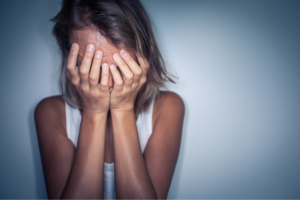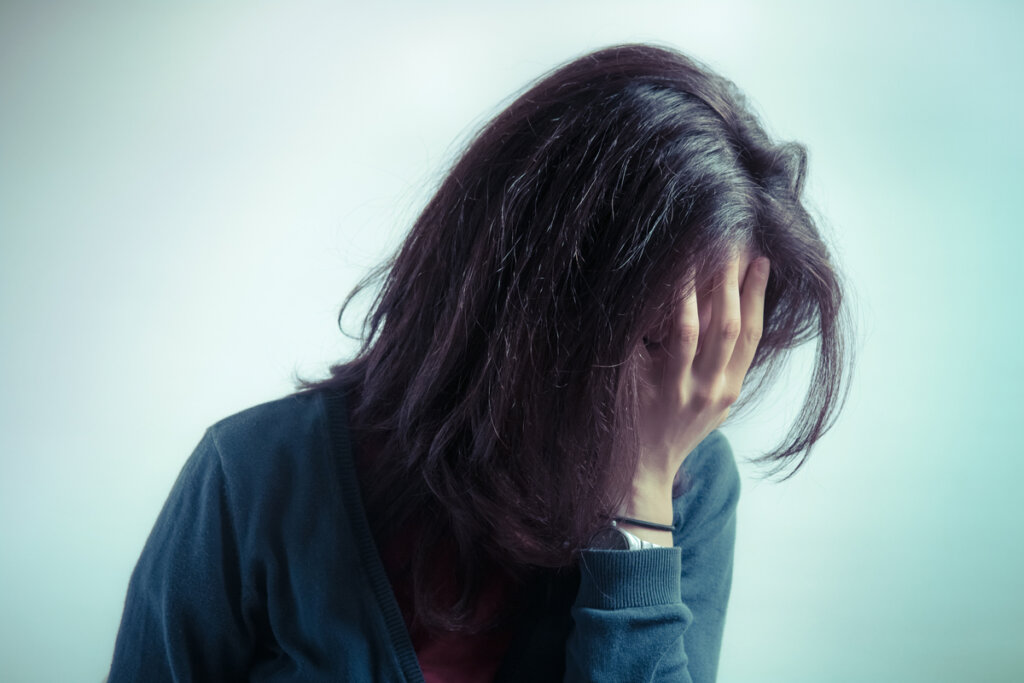The Fear of Fear: The Key to Anxiety Disorders

Anxiety is one of the most prevalent health problems in today’s society. Those who suffer from it know that it can easily become chronic and completely take over their lives. Furthermore, once developed, these types of disorders tend to perpetuate over time. However, why does this happen? What’s the mechanism that makes the symptoms so difficult to eliminate? In this article, we explain the importance of the fear of fear.
If you suffer from an anxiety disorder, you’ve probably noticed how specific symptoms end up becoming part of your identity. As a matter of fact, without you realizing it, fear has taken over your mind and your actions. This limits you in your daily life in multiple ways.
Perhaps you’ve been suffering anxiety for decades or maybe it’s more recent. Whatever the case may be, you need to understand how it works so that you can learn to deal with it.

Fear, the basis of anxiety
Fear is a basic emotion present in all human beings and necessary for survival. Its function is to alert us to an imminent danger and mobilize us to flee, defend ourselves, or get to safety. Without it, our physical or psychological integrity would be in danger. For this reason, we shouldn’t think of it as an enemy.
The problem occurs when fear is triggered in the absence of risks or in the face of stimuli or situations that are completely innocuous. In these circumstances, not only does it not bring you anything positive, but it also limits you, paralyzes you, and prevents you from functioning normally on a day-to-day basis.
Therefore, we could say that irrational fear forms the basis of anxiety. It’s the kind of fear that arises as a result of inadequate perceptions and interpretations of what’s happening, either externally or internally.
The fear of fear
No matter how necessary fear is for survival, we can’t deny that it’s an unpleasant emotion. It generates concern, a feeling of loss of control, and a great physiological activation. You perceive this state as negative and sometimes even traumatic. Therefore, if you suffer from anxiety, you begin to develop a fear of fear.
In fact, you no longer suffer only from having to face the situation that makes you afraid, but also from having to experience those unpleasant sensations. Thus, anticipatory anxiety begins. This means you remember how distressing the fear was that you felt and start to worry about how uncomfortable it’ll be to experience it again. The fear of being afraid then becomes a central part of the problem.
This is a phenomenon that’s very common in panic disorder and agoraphobia. Indeed, after a first episode of extreme anxiety (panic attack), the person begins to fear that it could happen again.
If this happens, you begin to constantly monitor your physical sensations. Furthermore, paradoxically, you tend to lower your threshold more and more. Eventually, you interpret every little sensation as the beginning of a new episode to be feared. Therefore, it’s the fear of fear itself that ends up triggering your symptoms.
Something similar happens with generalized anxiety disorder, social phobia, or any other anxiety disorder. To the central fear is added the fear of experiencing that anguish and discomfort typical of anxiety again.
Why is this concept key in anxiety disorders?
Being afraid of fear is a key concept in anxiety disorders. This isn’t just because it intensifies the discomfort or adds a new element of fear. In fact, above all, it’s because it causes the disorder to persist over time and become generalized.
In all cases, the fear is unfounded, irrational, or, at least, excessive. This is something that you could keep in check if you faced the feared situations and saw how harmless they really were.
However, the fear of feeling fear again makes you avoid exposing yourself to the situations that cause it by all means. Or, if you do, it’s for extremely short periods of time and generally using safety behaviors. For example, always sitting next to an exit, having a companion with you, or wearing an amulet.
This type of avoidance attitude only manages to reinforce fear and perpetuate it. That’s because it deprives you of the possibility of verifying that, in reality, nothing bad is going to happen.

Break free
In view of all the above, it’s clear that addressing the fear of fear is essential to treat any anxiety disorder. For this, exposure therapy is the most used and effective. It consists of being exposed to the stimuli or situations that cause fear, in an organized way and for sufficient time for the anxiety to be diluted.
In this way, you verify that physical sensations are not a sign of an imminent panic attack. Alternatively, you get used to the discomfort caused by social interaction, affirming that you’re able to face it without anything terrible happening.
You might reject this kind of therapy at the beginning. However, research has proved that daring to live through fear, and to feel it without running away, is the best way to alleviate it.
In sum, developing fear of fear is a frequent phenomenon and of key importance in anxiety disorders. If you notice that this is happening to you, or is starting to happen to you, don’t hesitate to seek professional help as soon as possible. It’s possible to approach it and work on it and obtain good results. This will free you from the limitations that the disorder imposes on you.
Anxiety is one of the most prevalent health problems in today’s society. Those who suffer from it know that it can easily become chronic and completely take over their lives. Furthermore, once developed, these types of disorders tend to perpetuate over time. However, why does this happen? What’s the mechanism that makes the symptoms so difficult to eliminate? In this article, we explain the importance of the fear of fear.
If you suffer from an anxiety disorder, you’ve probably noticed how specific symptoms end up becoming part of your identity. As a matter of fact, without you realizing it, fear has taken over your mind and your actions. This limits you in your daily life in multiple ways.
Perhaps you’ve been suffering anxiety for decades or maybe it’s more recent. Whatever the case may be, you need to understand how it works so that you can learn to deal with it.

Fear, the basis of anxiety
Fear is a basic emotion present in all human beings and necessary for survival. Its function is to alert us to an imminent danger and mobilize us to flee, defend ourselves, or get to safety. Without it, our physical or psychological integrity would be in danger. For this reason, we shouldn’t think of it as an enemy.
The problem occurs when fear is triggered in the absence of risks or in the face of stimuli or situations that are completely innocuous. In these circumstances, not only does it not bring you anything positive, but it also limits you, paralyzes you, and prevents you from functioning normally on a day-to-day basis.
Therefore, we could say that irrational fear forms the basis of anxiety. It’s the kind of fear that arises as a result of inadequate perceptions and interpretations of what’s happening, either externally or internally.
The fear of fear
No matter how necessary fear is for survival, we can’t deny that it’s an unpleasant emotion. It generates concern, a feeling of loss of control, and a great physiological activation. You perceive this state as negative and sometimes even traumatic. Therefore, if you suffer from anxiety, you begin to develop a fear of fear.
In fact, you no longer suffer only from having to face the situation that makes you afraid, but also from having to experience those unpleasant sensations. Thus, anticipatory anxiety begins. This means you remember how distressing the fear was that you felt and start to worry about how uncomfortable it’ll be to experience it again. The fear of being afraid then becomes a central part of the problem.
This is a phenomenon that’s very common in panic disorder and agoraphobia. Indeed, after a first episode of extreme anxiety (panic attack), the person begins to fear that it could happen again.
If this happens, you begin to constantly monitor your physical sensations. Furthermore, paradoxically, you tend to lower your threshold more and more. Eventually, you interpret every little sensation as the beginning of a new episode to be feared. Therefore, it’s the fear of fear itself that ends up triggering your symptoms.
Something similar happens with generalized anxiety disorder, social phobia, or any other anxiety disorder. To the central fear is added the fear of experiencing that anguish and discomfort typical of anxiety again.
Why is this concept key in anxiety disorders?
Being afraid of fear is a key concept in anxiety disorders. This isn’t just because it intensifies the discomfort or adds a new element of fear. In fact, above all, it’s because it causes the disorder to persist over time and become generalized.
In all cases, the fear is unfounded, irrational, or, at least, excessive. This is something that you could keep in check if you faced the feared situations and saw how harmless they really were.
However, the fear of feeling fear again makes you avoid exposing yourself to the situations that cause it by all means. Or, if you do, it’s for extremely short periods of time and generally using safety behaviors. For example, always sitting next to an exit, having a companion with you, or wearing an amulet.
This type of avoidance attitude only manages to reinforce fear and perpetuate it. That’s because it deprives you of the possibility of verifying that, in reality, nothing bad is going to happen.

Break free
In view of all the above, it’s clear that addressing the fear of fear is essential to treat any anxiety disorder. For this, exposure therapy is the most used and effective. It consists of being exposed to the stimuli or situations that cause fear, in an organized way and for sufficient time for the anxiety to be diluted.
In this way, you verify that physical sensations are not a sign of an imminent panic attack. Alternatively, you get used to the discomfort caused by social interaction, affirming that you’re able to face it without anything terrible happening.
You might reject this kind of therapy at the beginning. However, research has proved that daring to live through fear, and to feel it without running away, is the best way to alleviate it.
In sum, developing fear of fear is a frequent phenomenon and of key importance in anxiety disorders. If you notice that this is happening to you, or is starting to happen to you, don’t hesitate to seek professional help as soon as possible. It’s possible to approach it and work on it and obtain good results. This will free you from the limitations that the disorder imposes on you.
All cited sources were thoroughly reviewed by our team to ensure their quality, reliability, currency, and validity. The bibliography of this article was considered reliable and of academic or scientific accuracy.
- Sandín, B. (2005). Evitación interoceptiva: Nuevo constructo en el campo de los trastornos de ansiedad. Revista de Psicopatología y Psicología Clínica, 10(2), 103-114.
- Botella, C. B. (2001). Tratamientos psicológicos eficaces para el trastorno de pánico. Psicothema, 465-478.
This text is provided for informational purposes only and does not replace consultation with a professional. If in doubt, consult your specialist.







